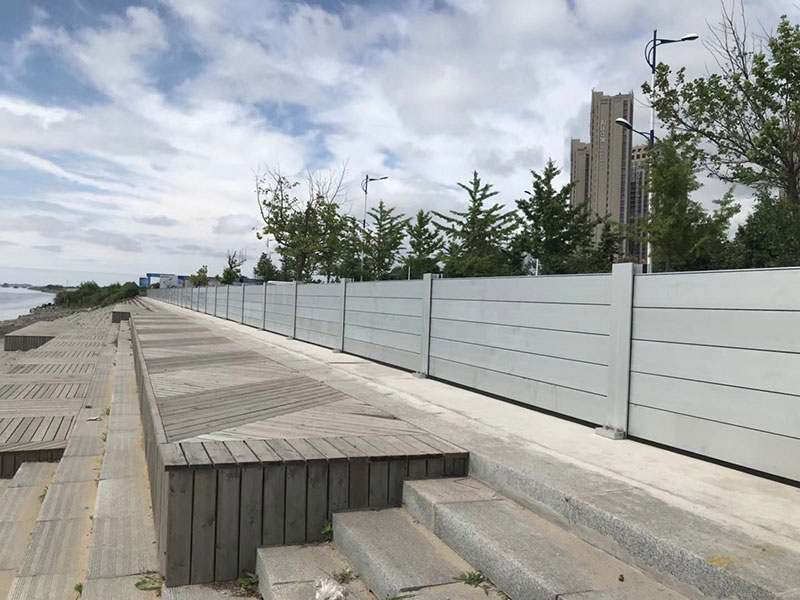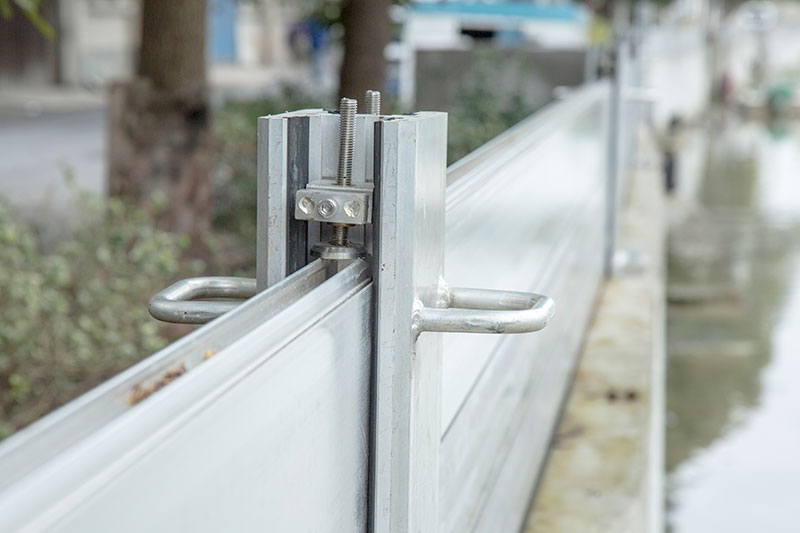Ports play a vital role in global trade and economic stability. Flooding poses a significant threat to these critical hubs, disrupting operations and causing costly damage. You need reliable solutions to protect ports from rising water levels. Demountable flood barriers for ports offer a practical and efficient way to safeguard port infrastructure. These barriers adapt to different environments and flood levels, ensuring optimal protection. Their quick installation and reusability make them ideal for ports, where space and time are often limited. By choosing demountable flood barriers for ports, you can enhance flood resilience while minimizing long-term costs and environmental impact.

Understanding Demountable Flood Barriers
Definition and Purpose
Demountable flood barriers are temporary structures designed to protect areas from flooding. You can install them quickly when a flood threat arises and remove them once the danger has passed. These barriers are ideal for ports, where permanent flood defenses may not be practical due to space constraints or environmental concerns. Their primary purpose is to safeguard critical infrastructure, cargo, and operations from water damage. By using these barriers, you can ensure that your port remains operational even during extreme weather events.
How They Function
Demountable flood barriers work by creating a watertight seal that prevents water from entering protected areas. You can deploy them rapidly, often within minutes, making them highly effective during emergencies. Unlike traditional methods like sandbags, these barriers require minimal labor and provide a tighter seal against surfaces. Some models activate automatically upon contact with water, further reducing the time and effort needed for deployment. Their reusability ensures long-term protection, making them a cost-effective solution for ports.
Key Features
Demountable flood barriers for ports come with several advanced features that enhance their performance and durability. Here’s a breakdown of their key components and materials:
| Component/Material | Description |
|---|---|
| Corrosion-resistant materials | Suitable for marine and corrosive environments |
| Steel or marine aluminum alloys | Provides structural integrity and durability |
| High mechanical resistance | Ensures the barrier can withstand significant forces |
| Very low leak rate | Less than 3 liters/hour/sqm |
| Quick installation | Takes only 5 minutes/sqm to set up |
| Maintenance-free | Requires minimal upkeep over its lifespan |
These features make demountable flood barriers a reliable choice for ports. Their lightweight design allows for easy handling, while their eco-friendly nature minimizes environmental impact compared to permanent structures. By choosing these barriers, you can protect your port without compromising sustainability.
Benefits of Demountable Flood Barriers for Ports
Quick and Easy Installation
You need flood protection that works fast during emergencies. Demountable flood barriers excel in this area. Their design allows for rapid deployment, often within minutes, ensuring your port stays protected when time is critical. These barriers rely on a well-designed setup, which simplifies installation and ensures effective flood resistance. Unlike traditional methods, such as sandbags, they require fewer connections and parts, reducing the risk of delays. You can install them at various locations, including doorways and perimeters, making them adaptable to your port’s unique layout. This flexibility minimizes logistical challenges and ensures a smooth response during flood events.
Reusability and Portability
Demountable flood barriers offer unmatched reusability. After the flood threat passes, you can dismantle and store them for future use. This feature makes them a sustainable choice for ports that face seasonal flooding. Their lightweight materials and modular design make transportation and storage easy. You can move them to different areas of the port as needed, ensuring comprehensive protection. Additionally, their adaptability allows you to adjust the barrier height based on flood predictions, providing tailored solutions for varying water levels. By choosing these barriers, you invest in a long-term, eco-friendly solution that reduces waste and supports efficient flood management.
Cost-Effectiveness
Demountable flood barriers for ports provide significant cost savings compared to permanent flood walls. Their optimized log sections reduce the need for additional supporting elements, making the system more economical. Maintenance-free materials further enhance their value by eliminating ongoing upkeep costs. Over time, their reusability lowers long-term expenses, offering a practical solution for budget-conscious port operators. These barriers also minimize disruption to port operations, ensuring business continuity and avoiding costly downtime. By investing in this cost-effective technology, you protect your port while keeping expenses under control.
Minimal Disruption to Port Operations
Flood events can bring port operations to a standstill, causing delays and financial losses. You need solutions that protect your port without interfering with daily activities. Demountable flood barriers for ports are designed to achieve this balance. Their temporary nature ensures they only occupy space when needed, leaving your port free for regular operations during non-flood periods.
These barriers allow you to maintain access to critical areas, such as loading docks, storage facilities, and transportation routes. Their modular design lets you deploy them in specific sections without blocking the entire port. This targeted approach ensures that essential workflows, like cargo handling and vessel docking, continue with minimal interruption.
You can also install these barriers quickly, often within minutes, reducing downtime during emergencies. Unlike permanent flood defenses, they don’t require extensive construction or modifications to existing infrastructure. This means you avoid disruptions caused by lengthy installation processes. Once the flood threat passes, you can dismantle and store the barriers, restoring the port to its normal state almost immediately.
Another advantage is their adaptability. You can adjust the barriers to fit different layouts and water levels, ensuring they meet your port’s unique needs. This flexibility helps you respond effectively to changing conditions without halting operations. By choosing these barriers, you protect your port while keeping business running smoothly, even during challenging weather events.
Applications of Demountable Flood Barriers in Ports
Protecting Critical Infrastructure
Flooding poses a significant risk to critical infrastructure in ports. You need to protect essential systems like utilities, emergency services, and transportation networks from water damage. Coastal flooding alone accounts for 28.2% of port-specific risks, while pluvial and fluvial flooding contributes 24.5% and 22.8%, respectively. These risks highlight the vulnerability of ports, especially in regions like Europe and the United States, where 12% of ports face the highest exposure.
Demountable flood barriers provide an effective solution for safeguarding these vital systems. Their quick deployment ensures that you can respond rapidly to rising water levels. By creating a watertight seal, these barriers prevent water from damaging electrical grids, communication lines, and other critical infrastructure. This protection helps maintain port functionality during extreme weather events, reducing the risk of prolonged disruptions.
Safeguarding Cargo and Storage Areas
Flooding can devastate cargo and storage areas, leading to financial losses and operational delays. You need a reliable way to shield these areas from water damage. Demountable flood barriers offer a cost-effective solution. Their optimized log sections reduce the need for additional support, enhancing economic efficiency. Maintenance-free materials further contribute to long-term savings, making these barriers a practical choice for port operators.
These barriers also provide flexibility. You can adjust their height to match predicted flood levels, ensuring tailored protection for valuable goods. Their modular design allows you to deploy them around specific storage zones, minimizing the risk of water intrusion. By safeguarding cargo and storage areas, you protect your investments and maintain the trust of your clients.
Ensuring Business Continuity
Flood events can disrupt port operations, causing delays and financial losses. You need solutions that minimize downtime and keep your business running smoothly. Demountable flood barriers excel in this area. Their rapid installation allows you to respond quickly to flooding threats, ensuring that critical workflows continue with minimal interruption.
These barriers also adapt to varying flood levels, providing reliable protection during severe weather. Their reusability makes them a cost-effective alternative to permanent flood defenses, reducing long-term expenses. By investing in demountable flood barriers for ports, you enhance your port’s resilience and ensure uninterrupted operations, even during challenging conditions.
Temporary Solutions for Seasonal Flooding
Seasonal flooding can disrupt port operations and damage infrastructure. You need a reliable, temporary solution to address these recurring challenges. Demountable flood barriers for ports offer an effective way to manage seasonal flooding without committing to permanent structures.
These barriers are ideal for ports that experience predictable flooding during specific times of the year. You can deploy them quickly when water levels rise and remove them once the threat subsides. Their modular design allows you to adjust the height and length based on the severity of the flood. This flexibility ensures that your port receives tailored protection every season.
Here are some reasons why these barriers work well for seasonal flooding:
- Ease of Storage: After use, you can dismantle and store the barriers in compact spaces. This feature saves valuable port space during non-flood periods.
- Cost Efficiency: Reusing the same barriers each year reduces costs compared to building permanent flood defenses.
- Adaptability: You can move the barriers to different areas of the port as needed, ensuring comprehensive coverage.
By using demountable flood barriers, you protect your port from seasonal flooding while maintaining operational efficiency. These barriers provide a practical, temporary solution that adapts to your port’s unique needs. Their reusability and ease of deployment make them a smart investment for ports facing recurring flood risks.
Considerations for Implementing Demountable Flood Barriers
Material Selection and Durability
Choosing the right materials ensures the long-term effectiveness of demountable flood barriers. You need materials that can withstand harsh marine environments and resist corrosion. The following table highlights some of the most durable materials used in constructing these barriers:
| Material Type | Durability Features |
|---|---|
| Corrosion-resistant materials | Built to withstand exposure to river water, seawater, and harsh weather conditions, ensuring a long lifespan with minimal maintenance. |
| Corrosion-free steel/marine aluminum alloys | Designed to remain corrosion-free for over 20 years, ensuring sustainability and lasting flood protection. |
These materials not only enhance the lifespan of the barriers but also reduce maintenance costs. By selecting high-quality materials, you ensure that your port remains protected during extreme weather events.
Maintenance and Storage
Proper maintenance and storage are essential for keeping your flood barriers in optimal condition. You should follow these best practices to ensure their effectiveness:
- Conduct regular inspections, especially before the rainy season, to identify any wear or damage.
- Keep the area around the barriers clean and free of debris to prevent obstruction.
- Store the barriers in a dry, cool place away from direct sunlight to avoid material degradation.
- Check seals and joints regularly to ensure they remain intact and watertight.
- Follow the manufacturer’s guidelines for maintenance and storage to maximize the lifespan of the barriers.
Integration with Existing Infrastructure
Integrating demountable flood barriers with your port’s existing infrastructure requires careful planning. These barriers are designed to adapt to various layouts and conditions, making them highly versatile. Here’s how you can ensure seamless integration:
- Use heavy-duty barriers that can withstand extreme maritime conditions, ensuring reliable protection.
- Opt for adaptive configurations that allow the barriers to fit into your port’s unique layout without disrupting operations.
- Choose modules that connect smoothly with existing walls and facilities, enhancing overall flood resistance.
- Tailor the barrier system to match your port’s geometry and load requirements.
By considering these factors, you can implement demountable flood barriers for ports effectively. This approach ensures that your port remains resilient against flooding while maintaining operational efficiency.
Training for Deployment and Preparedness
Proper training ensures you can deploy demountable flood barriers for ports quickly and effectively during emergencies. Without preparation, even the best flood protection systems may fail to deliver optimal results. Training equips your team with the skills and confidence needed to handle flood threats efficiently.
Key Areas of Training
- Deployment Techniques
Teach your team how to assemble and install the barriers. Focus on proper alignment, securing connections, and creating watertight seals. Practice deployment in different areas of the port to familiarize your team with various layouts and conditions. - Emergency Response Drills
Conduct regular drills to simulate real-life flood scenarios. These exercises help your team respond faster and identify potential challenges. Drills also ensure everyone understands their roles during emergencies. - Inspection and Maintenance
Train your staff to inspect the barriers for damage or wear before deployment. Teach them how to check seals, joints, and other critical components. Regular maintenance training ensures the barriers remain in top condition. - Storage and Handling
Proper storage extends the lifespan of the barriers. Train your team to dismantle and store the barriers correctly. Emphasize safe handling practices to prevent damage during transportation or storage.
Benefits of Training
Well-trained staff can deploy barriers faster, reducing response times during floods. Training minimizes errors, ensuring the barriers perform as intended. It also boosts team confidence, helping them stay calm and focused under pressure. By investing in training, you maximize the effectiveness of your flood protection system and enhance your port’s resilience.
Flood protection is essential for ports to maintain operations and safeguard infrastructure. Demountable flood barriers offer numerous advantages, including adaptability, quick installation, and cost-effectiveness. These barriers protect critical areas like doorways and perimeters while minimizing environmental impact through reusability. You can enhance flood resilience by adopting proactive measures such as deploying watertight defenses, raising structures, and creating emergency plans. Collaborative efforts among stakeholders also strengthen flood management strategies. Consult experts to design tailored solutions for your port. By acting now, you ensure long-term protection and operational continuity during extreme weather events.

